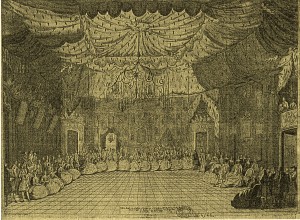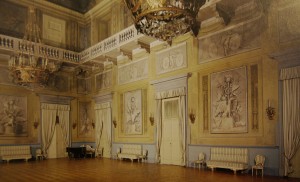Remarks on the lighting devices between the 17th and the 18th century
by Laura Balboni, Paolo Corradini, Angelo Landi
Politecnico di Milano, Department Architecture and Planning
PhD in preservation of architectural heritage
Reports, diaries of travelers who cross Italy, XVIIIth gazettes, often treat about suggestions and references regarding the topic of the artificial light. Admired expressions such as “illuminata a giorno” or “illuminato a profusione”, that means “lit up in profusion”, often recur in descriptions. Besides, the role played by illuminators was considered the same as that of gilders, florists, decorators and this shows the great importance ascribed to light.
The possibility of lighting artificially is not within the reach of everybody and therefore it defines an ‘elite’.
It is a means which can extend the times of living till then marked by the sun light, when new behaviour and habits, which become peculiar to a noble and rich social class, are defined.
The research is focused on the presence of artificial light inside aristocratic palaces, and if and how this aspect might have influenced and defined them; taking into account a period between the end of the Sixteenth century and the first half of the Seventeenth, the examples are related to the Duchies of the Este and Farnese Families, and then compared to some examples and experiences in other areas in Italy, such as Turin, Genoa and Milan. In this sense inventories, descriptions of chroniclers and travellers, iconography, with their limits, have been our main instruments to carry out our research.
On this subject, it is perhaps appropriate to remember what De Brosses said on visiting the court of Modena in 1740. He relates his talks with the marquis Rangoni who bitterly complains about the confusion brought about by the French Duchess of Modena, Carlotta Aglae d’Orleans imposing “the amusing habit of playing biribisso all night long, having supper at six in the morning and going to bed at eight”. This curious anecdote about the lively personality of Carlotta at the severe and stern court of Modena highlights an interesting aspect: the introduction of a new style of life tending towards living at night and coming from France, upset and influenced the cultural habits of the quiet and peaceful centre of Modena. Furthermore, this fact raises some questions about the changes and role played by artificial light.
Inventories analysed of the second half of the XVII century generally show the absence of chandliers, such as in the Ducal Palace in Sassuolo (MO), the main extra moenia residence of the Duchies of Este.
An accurate inventory dated back 1679 shows, inside the richly decorated and furnished rooms, the absence of any illuminating devices; besides, there is only a limited number of mirrors. It’s important to remember that the description of guardaroba is missing, so it’s not possible to say if chandeliers or other fittings might have been kept inside it: as shown in other examples, candlesticks in different in materials and shape were linked to different functions, and quite often it is possible to recognise displacements of “piece of lighting” as well as “piece of furniture”.

Fig. 1, J. B. Boudard, “Salon donde se celebro el festin que el Cardenal Porto Carrero hizo eregir en Parma en la Celebridad del Baptismo del real Principe”. Published in Francesco Baroncelli, Palazzo Farnese Rangoni: sede della Prefettura di Parma, Battei, Parma, 2007, p. 23
When there are lighting devices, they are placed in relation with the importance and use of the room: in Palazzo Rangoni in Parma the unique lighting devices recorded follow the order of the baroque ceremònial, which has been well described by Anna Maria Matteucci: on crossing the main door a “lanternone” lit the entrance-hall; from here you can reach the great staircase which is also lit with a “lanternone” and then arrive at the large reception room. However, it is to be noted that no mirrors are on the walls, and the source of lighting is totally ascribed to the lighting devices (Fig. 1, J. B. Boudard, “Salon donde se celebro el festin que el Cardenal Porto Carrero hizo eregir en Parma en la Celebridad del Baptismo del real Principe”. Published in Francesco Baroncelli, Palazzo Farnese Rangoni: sede della Prefettura di Parma, Battei, Parma, 2007, p. 23).
An interesting question is about if and how this topic start taking part also in the architectonic plan of the new-built or reformed room in 18th century.

Fig. 2, Ducal Palace in Modena, the “Gran Sala”. Published in Elena Corradini, Elio Garzillo, Graziella Polidori (ed.), Il Palazzo Ducale di Modena: regia mole maior animus, Fondazione Cassa di Risparmio di Modena, Modena, 1999, p. 135
In the ducal palace of Este in Modena, the main palace of the ducal family in its own capital, an inventory of 1771 records a deep evolution in the lighting devices, if compared with documents of previous periods. We can observe a great effort in lighting the “grande nobile appartamento”, but what is more surprising is the Gran Sala. Also in order to understand the richness of information reported by inventories, they describe that it was lit by steady lighting devices of excellent manufacture (such as Venezia crystal, Boemia crystal, crystal of rocca, gilt and carved wood, brass ornamental elements) bearing 927 flames: 13 lumiere, richly decorated with leaves, drops and medals were hanging from the vault, and they were different in form and dimensions. Among them, one is defined “stragrande” and it had 72 candles. Other 4 ones, with 24 candles, are made by Venice crystal, and the last ones, with 8 candles, in Bohemia crystal. The walls were lit on the ground floor by 13 appliqués with 5 arms, and the mirrors increased the lighting. At the upper level, the gallery sustained by pillars, realized by Francesco III to place the orchestra, contributes to the lighting project bearing 35 cornucopiae, each one with 18 flames, that took part in giving light to the whole space.
If for the lighting plan we can see a different solution for each level, the brief description of devices – all them were made in silvered-metal with brass leaves – reports about the attempt to use the same formal language for the room. So, apart from the high number of chandeliers, the document makes us aware of the great complexity of a project, which involved also the architectural elements, and which tried to solve the problem of lighting in the wide 17th hall. (Fig. 2, Ducal Palace in Modena, the “Gran Sala”. Published in Elena Corradini, Elio Garzillo, Graziella Polidori (ed.), Il Palazzo Ducale di Modena: regia mole maior animus, Fondazione Cassa di Risparmio di Modena, Modena, 1999, p. 135).
In different geographic contexts the issues connected with the artificial illumination are not only limited to the implementation of the illuminant devices or to their adaptation to the existing spaces. It is possible to find some interesting cases in which it’s quite evident a certain awareness on illumination aspects, which were developed in the planning phase of complex lighting systems, and lighting devices were completely integrated, also in an aesthetic manner, with the architectonic and figurative elements in the wide halls and galleries.

Fig. 3, M. L. Quarini, “Salone del Reale Palazzo di Stupinigi apparato per il Ballo”, 1773. Published in Gritella Gianfranco, Stupinigi. Dal progetto di Juvara alle premesse neoclassiche, Franco Cosimo Panini editore, Modena 1987, p. 270
In the “Salone” in the Palazzina di Caccia in Stupinigi in Turin, started been built in 1729, Filippo Juvarra projected the architectonic system as well as many decorative details, such as the design of the lighting devices: it consists of thirty-six appliqués placed on the twenty-four pilasters and on the central four pillars (the appliqués on the balustrade and the chandelier were installed several years later). The thirty-six wood-made appliqués represents the head of the deer and are in copper and silver, painted “with the Pearl grey colour and the Prussian blue”.
An interesting solution is proposed for the chandelier, probably placed in 1773 on the occasion of the wedding of Carlo Filippo d’Artois and Maria Teresa di Savoia. The architects who had to plan the lighting system in the interior were worried about the necessity to open some holes in the vault of the Hall hanging some chandeliers, afraid to overburden the structure. For this reason only one single chandelier was fixed to the vault, and several lighting fittings were anchored to the balustrade (Fig. 3, M. L. Quarini, “Salone del Reale Palazzo di Stupinigi apparato per il Ballo”, 1773. Published in Gritella Gianfranco, Stupinigi. Dal progetto di Juvara alle premesse neoclassiche, Franco Cosimo Panini editore, Modena 1987, p. 270).
Also moving to Milan we can observe some early examples showing a great knowledge and sensibility on lighting aspects. In the “Gran Sala da Ballo” in the Palazzo Regio-Ducale, rebuilt at the middle of the XVIIIth century, the lighting apparatus was modified several times, in order to get satisfactory results. A part from adding different kinds of chandeliers or appliqués, the changes involved also aspects related to furniture and architecture. For instance in 1765 the Governor Pallavicini, convinced that during the parties the Salone was too dark, ordered “to take away the family portraits and to put mirrors on the empty spaces”. Also decorations have to do with: after adding “26 iron appliqués […] in the shape of chandeliers” to be hung below the balcony, the architect Francesco Croce noticed that “the light yellow colour of the walls” completely disappeared in comparison with the stuccos and the gilded frames of the mirrors, and decided to use a false gilding less bright than the colour used before for the gilding of the stuccos.
The awareness of the importance of surfaces on the final result of candle lighting is well described by some letters of the Governor: when his wife Anna sent him some “velluti alla giardiniera” to tapestry a few rooms of the Palazzo Regio, he criticized the bad hue of colours shown by the candle light. His wife just answered she had bought the velvet textiles by the light of candles and when the windows had been closed.
These continuous changes point out the difficulties in planning and controlling the lighting technique parameters, but also the attention rated to them.
The increasing number of candles opened also other kind of problems: they gave off a lot of smoke, therefore some openings were made in the vaulting roof so as to let the smoke out of the hall. But it was not enough, and a year later the Archduke Ferdinando began the restore the Sala, in order to clean the vault blackened by smoke.
The inventory written down in 1770 for the Palazzo Clerici in Milan, allows us to quantify the value of the lighting devices: the great Venetian chandelier with 40 candles, in the Salone, was estimated £ 1250; the 6 chandeliers with 24 candles were valued £ 2800; the 48 appliqués in the Gallery just £ 450. Their values are assimilable to the most luxurious furnishings of the palace such as velvets, trumeaux, tapestries and canapè: therefore it is clearly the representative role of the lighting fixtures.
In conclusion, the research tried to link some case studies, some of them briefly reported in this abstract, looking for connections between the arrangement and planning of halls in palaces and the evolution in the use of artificial light. The aim of the research is not to give an answer, but the suggestions from this point of view underline some aspects which could be useful in the wider and more complex study of the great halls in Barock palaces. Besides, with these some reflections can be stimulate about the contemporary plan of lighting in ancient palaces: mainly in the less-known buildings, planners rarely deepen the previous ways of lighting and their reasons, that could give useful information in order to get an aware project of restoration.
No Comments, Comment or Ping
Reply to “Artificial light in the aristocratic palaces in the Po valley”